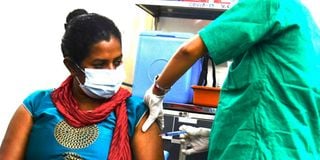Scientists discover new Covid variant

A health worker inoculates a woman with a dose of the Covid-19 vaccine at Nair Hospital in Mumbai, India, on October 21, 2021.
A new coronavirus variant has been discovered in 20 countries, with researchers sounding the alarm over its spread.
The Omicron sub-variant BA.2.75, nicknamed ‘Centaurus’, is increasing in India, though hospitalisation and death rate remain very low.
The researchers, through studies, are waiting to learn whether it will substantially surge after a wave of cases.
However, some studies have suggested that it has a similar capacity to dodge immunity conferred by infection and vaccination, hence suggesting that it might not push cases much higher outside India—at least not while population immunity is high.
In December last year, Kenya reached an all-time high Covid-19 infection rate, which is believed to have been fuelled by the highly transmissible Omicron variant. Despite the high numbers, not so many people were hospitalised. The death rate was also low, with only outpatient numbers doubling.
Researchers in India have sequenced more than 1,000 samples of the latest variant since May. About two-thirds of new cases there are due to BA.2.75, says Prof Shahid Jameel, a virologist at the University of Oxford.
According to the findings published in the Nature journal yesterday, the variant is said to have “quite a sizeable” transmission advantage over BA.5 in India, adding that it would definitely cause an infection wave.
It states that the number of confirmed cases is up across India and the number of tests that turn positive is high.
The study suggests that in other countries, including Japan, the United States and the United Kingdom, cases caused by the variant are relatively low, adding that it might not trigger big waves in most places.
“The variants are now competing with each other and they’re almost equivalent,” says Prof Jameel. “I think people who have had BA.5 will not have breakthrough infection with BA.2.75 and vice versa.”
Dr Yunlong Richard Cao, an immunologist at Peking University in Beijing, says that the explosion of numbers in India caused by the variant was because they share a key mutation with Delta variant, which leaves an opening for BA.2.75.
Dr Cao and his team found that several people who had had Delta infection after vaccination produced antibodies that were more potent against BA.5 than against BA.2.75.
“My guess is that BA.2.75 probably won’t prevail that much outside India, especially in countries that weren’t hit hard by Delta,” he adds.
He predicts that BA.2.75 will continue to grow globally, particularly in Asia and Oceania.
Dr Ahmed Kalebi, a consultant pathologist, said even with the slow spread of the variant, there is a need to be cautious to ensure not so many people are infected.
“This is the same way that the Omicron behaved not so many people were hospitalised, but so many were infected. Because many had been vaccinated the number of people that were severely infected remained very low,” he said, adding it is just a matter of time before the variant is reported in Kenya.
“If we are moving, the variant is also moving.”
Over the past two months, the country has been recording less than two cases a day, with a one per cent positivity rate in the last two weeks. This means Kenya has flattened the curve.
The World Health Organisation declaration of a flattened curve requires a daily positivity rate of below five per cent for two weeks consecutively.





